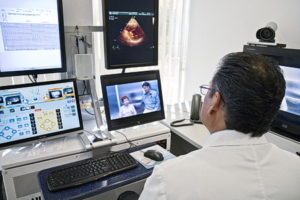Photo by Wavebreakmedia – yayimages.com
Overview
The prostate is a small gland located in the lower abdomen of male mammals. It is a small-sized gland located at the neck of the bladder and is responsible for secreting fluid for the nourishment of sperm. The gland is regulated by testosterone, which is the male reproductive hormone.
Malignant growth of cells in the prostate gland is known as prostate cancer. Cancer is this region can quickly spread into other parts of the body, including the bones.
According to the American Cancer Society, the number of prostate cancer patients in the US is expected to be 174,650 in 2019. It is the second leading cause of cancer-related deaths in American men.
How Can We Prevent Prostate Cancer?
There are two types of prostate cancer and are categorized according to how fast they can grow.
- Aggressive Prostate Cancer
- Non-aggressive Prostate Cancer
Aggressive cancers grow very quickly and can spread easily into other organs. Aggressive prostate cancer can affect bones in very little time. Non-aggressive prostate cancer, on the other hand, does not grow very quickly.
Causes
Prostate cancer mainly affects men older than 65 years of age. Around 60% of the reported cases are diagnosed in men over 65, but that is not always the case. In April 2000, 55 year old former New York City mayor Rudolph Guiliani announced that he had prostate cancer, but it was found in the early stages and the tumor was successfully removed.
Causes of prostate cancer are still not known. However, doctors agree that genes, obesity, and diet are some of the most important contributing factors.
Diet
 Men who consume large amounts of red meat and animal fat cooked at high heat are more prone to developing prostate cancer. Research has shown that men in countries where meat and dairy products are a staple diet are more likely to develop prostate cancer.
Men who consume large amounts of red meat and animal fat cooked at high heat are more prone to developing prostate cancer. Research has shown that men in countries where meat and dairy products are a staple diet are more likely to develop prostate cancer.
However, the results are different in countries where a basic diet, like vegetables, fruits, and rice, is consumed. In general, a good diet along with exercise can defintitely help in lowing the chances of getting this disease.
Obesity
 One of the most important causes of prostate cancer is obesity. Fats stimulate the production of the male reproductive hormone called testosterone. High levels of testosterone may increase the production of prostate cancer cells.
One of the most important causes of prostate cancer is obesity. Fats stimulate the production of the male reproductive hormone called testosterone. High levels of testosterone may increase the production of prostate cancer cells.
This shows that people with a high Body Mass Index (BMI) are more prone to developing this illness.
Genes
![A DNA adduct (at center) of benzo[a]pyrene, the major mutagen in tobacco smoke](http://howard-fensterman-charities.com/wp-content/uploads/2016/08/CC-G-Wikimedia-040819a-650px-Benzopyrene_DNA_adduct_1JDG.png)
Mutations in certain genes can also cause cells to grow abnormally. The abnormal growth of cells can cause a tumor. These mutated cells can continue to live and grow even when other cells die. They might also spread into other organs.
If men in your family have a history of prostate cancer, you are also likely to develop this disease. Just like breast cancer, prostate cancer can also be inherited.
Early Signs of Prostate Cancer
Prostate cancer can grow silently without causing any apparent signs and symptoms. The disease can go unnoticed for years. This is the reason why regular screening for prostate cancer is very important after you cross the age of 50.
Most signs and symptoms of prostate cancer appear after the tumor has spread. These early signs and symptoms may include difficulty in urination, burning sensation in urine, blood in urine and stool, pain in ejaculation and pain in the lower back, hips thighs and pelvis.
Some of the symptoms of an advanced-stage tumor include loss of appetite, a drastic reduction in weight, fatigue, nausea and vomiting, severe lower body aches, and bowel problems.
Diagnosis
 Men over 50 are recommended to go for regular screening for prostate cancer. This cancer is more common than other cancers, but successful treatment is high if caught early and there are numerous methods now with regards to how to treat it.
Men over 50 are recommended to go for regular screening for prostate cancer. This cancer is more common than other cancers, but successful treatment is high if caught early and there are numerous methods now with regards to how to treat it.
Diagnosis of prostate cancer can be done through one or both of the following methods.
Digital Rectal Exam
During DRE, a doctor physically examines the prostate to find any abnormalities in shape, size, and texture of the gland.
Prostate-Specific Antigen (PSA) Test
This is a blood test where a blood sample is drawn and examined for the presence of PSA. PSA is naturally produced by the prostate gland. Higher ranges of PSA in blood levels may indicate an infection, inflammation, or even cancer. On one case, a 57 year old male was diagnosed with a high PSA but the urologist determined that he has not developed any signs of cancer.
The man is now 63 and still shows the same high PSA but is still free and clear of any dangers to his prostate. Now this might be rather unique so it is still recommended that men over 50 should visit a urologist yearly or more often if needed as a precaution.
Depending upon the results of DRE and PSA tests, your doctor may recommend further tests, including ultrasound, MRI scan, and a biopsy. Tests are also conducted to find out whether the cancer is aggressive or non-aggressive.
Treatment
The treatment of prostate cancer is dependent upon the stage and whether it is aggressive or non-aggressive. Treatment also depends upon the overall health of an individual and severity of symptoms.
One or more of the following methods may be used to treat prostate cancer.
Surgery
Surgery for prostate cancer usually involves removing the prostate gland and some of the surrounding tissues. The surgery can be done using robotic assistance. A microscopic instrument is inserted to facilitate more precise removal of the affected tissue.
More conventional surgery involves an incision in the lower abdomen, and the prostate gland is taken out through the incision.
Radiotherapy
Radiotherapy uses high powered energy to kill the extra growth of tissues. Treatment for prostate cancer can be provided using two methods.
- Radiation from Outside – The affected area undergoes the external radiation to kill cancer cells.
- Radiation from Within – A small sized radioactive seed is placed in the prostate tissue, which continues to deliver small doses of radiation over a period of time.
Chemotherapy
Powerful drugs are injected into the body to kill the cancer cells. Chemotherapy may be used in case cancer has spread to other areas of your body. The drawback of this therapy is that it can also kill healthy normal cells along with fast-growing cancer cells.
Other treatments include hormonal therapy, biological therapy, and freezing of prostate tissue. Only your consultant can suggest the right treatment after analyzing your condition.

